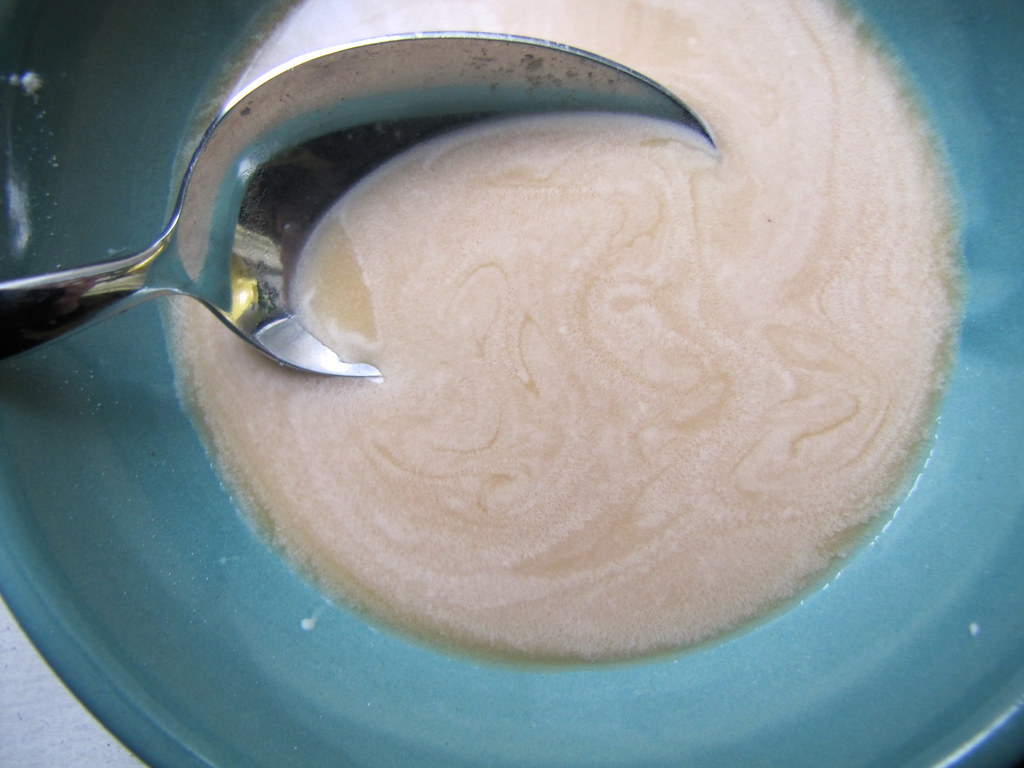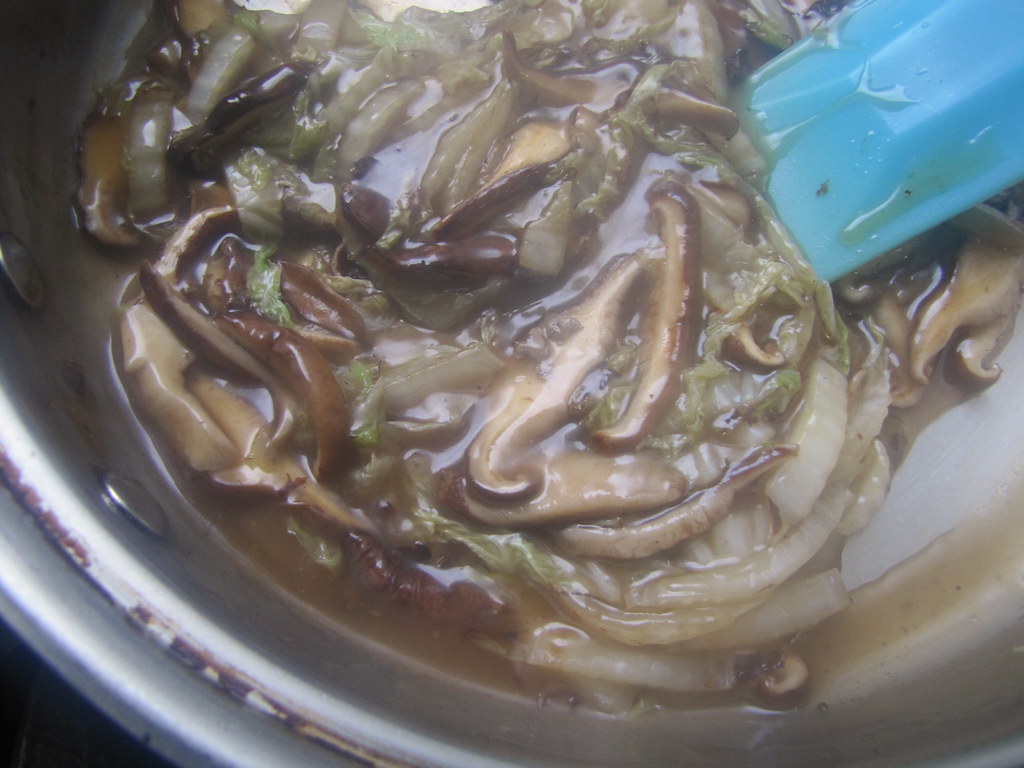Here’s my new take on a standard beef stir-fry with vegetables over rice. I like to use a good cut of good, grass-fed beef to its fullest, and I love the tenderness of a rare-cooked steak, whose drooling juices contribute to the rich flavors of ample marbling (aka fat). Here, I’ve taken a decent cut (sirloin) of really good, pastured beef and added one other benefit: a light marinade for flavor and texture, in the style of a Chinese stir-fry.
Meat preparation was one of the biggest food-culture shocks for my mom when she moved to the States from Taiwan in her twenties. She had never seen nor eaten before a big, whole piece of cooked beef (aka “steak” or “roast”) before coming here — it was always cut bite-size, to be quickly cooked in a hot pan, typically. Knives were designated for the kitchen, not serving table, and this was just a matter of course. But it didn’t take long for her to appreciate the bloody-rare steaks that her new father-in-law loved to prepare.
You don’t need to have broccoli or bell peppers to accompany beef in a stir-fry. Now that it’s winter, and few bright-colored, usual suspects for this preparation are around, I got a clutch of fresh shiitake mushrooms and a small head of napa cabbage to round out the meal tonight. These mushrooms are a special treat — silky and soft when cooked, with intense, woody flavor. I was going for a classic steakhouse accompaniment, with a twist, but if you can’t find shiitake mushrooms, proceed with plain old button ones instead. Likewise, instead of napa cabbage, try savoy cabbage, whose crinkly, soft leaves and sweetness are much on par with the archetypical Asian green. Or use common green cabbage, whose denser leaves will be sliced and stir-fried until gently browned and softened anyhow.
 fresh shiitake mushrooms
fresh shiitake mushrooms
 sliced up along with napa cabbage leaves
sliced up along with napa cabbage leaves
Now, the most typical cut of beef to stir-fry with would be flank. Why? Because it has a sharply defined vertical grain that you can slice against thinly, creating more textured, tenderized individual pieces. Imagine slivers of celery, sliced against its fibrous strands, as opposed to along them. My gripe with packs of pre-sliced “stir-fry” beef that you find in conventional grocery stores is that it betrays this advantage, cutting random strips of who knows what cut of beef, often. The other reason why flank is usually used for stir-fries is that it’s a generally less tender, less fat-marbled cut, so not as delectable for other applications unless stewed forever.
 fixing a garlicky quick marinade
fixing a garlicky quick marinade
You also don’t need a hoard of sauces or any exotic cooking techniques to make this satisfying winter dish that straddles East and West neatly. Taking cues from both stir-frying and a seared steak with a reduced wine sauce and savory mushrooms in the French/Western tradition, I made a pretty mean supper for one tonight. While the rice was cooking, I let that whole slab of sirloin marinate in a splash of soy sauce, chopped garlic and dose of baking soda. What? My uncle is a fan of adding a pinch of baking soda to beef while it marinates before stir-frying, and swears that it helps tenderize the meat further. I can’t be sure, but I think it does. Also, it’s an ingredient that I have readily on hand — along with garlic and soy sauce — and figure that the extra measure should at least be taken here, since I’ll be cooking an entire steak rather than clean slivers in any case.
 the cornstarch slurry
the cornstarch slurry
 and the thickened sauce after its addition
and the thickened sauce after its addition
Next, mix up a spoonful of cornstarch with water and another splash of soy sauce, to keep at bay to thicken the mushroom and napa cabbage mixture with once it’s sauteed. This will give it the saucy, glossy consistency and glow. It’s what you would stir into a typical Cantonese stir-fry once it’s all seasoned and cooked.
Depending on how thick your steak is or how you like it done, this should take only 5-10 minutes from the moment the steak hits the pan to being served atop the vegetables and rice. I decided to slice up the steak pre-serving, so I could easily grab at it with chopsticks. But, you can always leave it intact and place a mean-looking steak knife at the table.
Soy-Marinated Steak with Shiitake Mushrooms and Napa Cabbage
(makes 2 servings)
about 1 lb (or enough for two) steak, such as sirloin, skirt, hanger, or flank
1/4 lb fresh shiitake mushrooms, stems trimmed and thinly sliced
8-10 leaves napa cabbage, thinly sliced
2 cloves garlic, chopped
2 tablespoons soy sauce
1/4 teaspoon baking soda
1/2 cup Chinese rice cooking wine, or Japanese rice wine, sake
1 teaspoon cornstarch
salt and black pepper to taste
2 tablespoons vegetable oil
1-2 scallions, chopped (optional)
Rub the steak with the garlic, baking soda and 1 tablespoon of the soy sauce, along with a generous pinch of salt and pepper. Cover and let marinate for 20-30 minutes while you prepare the rest of the ingredients.
Combine the cornstarch with the remaining tablespoon of soy sauce and 1/2 cup water in a small bowl.
Heat a heavy-bottomed pan with 1 tablespoon of the vegetable oil over high heat until it begins to sizzle. Wipe off all the garlic from the steak with paper towels. Place into the hot oil and let cook without moving for at least 30 seconds. Once the bottom is nicely browned, reduce heat to medium and carefully flip. Let cook on the opposite side for 2-3 minutes, depending on the thickness of the steak and how well you prefer it to be cooked. Keep in mind that the steak may continue to cook a little after it’s taken out of the pan. Transfer steak to a cutting board to rest. Wipe out any black or burnt bits from the pan carefully using paper towels, but do not clean it thoroughly.
Add another tablespoon of oil to the same pan and heat over medium-high. Once hot, add the mushrooms and napa cabbage along with a pinch of salt and pepper. Cook, stirring occasionally, for 2-3 minutes, or until the vegetables are translucent and lightly seared in spots. Add the sake and bring it to a boil. Stir up the cornstarch mixture in the bowl once more before pouring it into the pan. Stir immediately while the sauce thickens. Taste for seasoning. Remove from heat. Once the steak has rested five minutes, slice into bite-size pieces, and plate it along with the vegetable mixture and rice, with the optional chopped scallions for garnish.
Cost Calculator
(for 2 servings)
1 lb sirloin steak (from Tamarack Hollow Farms at the Union Square Greenmarket): $8.99
1/4 lb fresh shiitake mushrooms (at $19.99/lb): $5.00
8-10 leaves napa cabbage (at $3/head): $0.50
2 tablespoons soy sauce: $0.25
1/2 cup rice wine: $0.75
2 cloves garlic: $0.05
2 scallions: $0.35
1/4 teaspoon baking soda, 1 teaspoon cornstarch, salt, pepper, vegetable oil: $0.30
Total: $16.19
Health Factor![]()
![]()
![]()
![]()
![]()
![]()
Six brownie points: This is definitely in the category of heavy, meaty winter food, with a generous portion of beef per serving. But it’s actually a well-balanced meal, especially with the addition of wholesome brown rice. The napa cabbage provides Vitamin C and many other vital nutrients found in all winter cabbages. And the sauce employs a simple starch-thickened solution rather than butter or heavy cream to enrich it.
Green Factor![]()
![]()
![]()
![]()
![]()
![]()
![]()
Seven maple leaves: The three main ingredients — steak, mushrooms and napa cabbage — were each sourced from the NYC’s Greenmarkets and are in season now. There is a definite increased environmental toll when you consume animal protein as part of your diet, but also responsible animal raising techniques practiced by small farmers that you can support by purchasing from. This recipe supports the latter persuasion, and the flavorful meat thanks to thoughtful raising and feed is another good reason to as well.

 sirloin steak
sirloin steak
2 Responses
For The Love Of Food | Upgrade Your Healthstyle | Summer Tomato
[…] Soy-Marinated Steak with Shiitake Mushrooms and Napa Cabbage <<An excellent example of why to not stop eating. Yum. (Not Eating Out In New York) […]
Cheap Cookware & Delicious Recipes » How to Cook Napa Cabbage
[…] Soy-Marinated Steak with Shiitake Mushrooms and Napa Cabbage … […]